Keywords
Pergularia daemia; Anti-inflammatory; Antiarthritic; %Membrane stabilization; %Inhibition of protein
Introduction
The medicinal plants are regarded as a precious gift provided by the nature in the free of cost and they have been used by the humans from ancient period. From olden days they have been used by the peoples of various cultures as a safe therapeutic approach. According to WHO, about 80% of the world population specially in developing countries are mostly depend on the traditional medicine from plants for their healthcare [1] in the form of tea, decoction or extracts with water, milk (or) alcohol [2] and WHO has also recommended to use plants as medicines where the conventional medicine is not easily available [1]. The holistic systems of medicine such as Ayurveda, siddha, homeopathy, unani are in practice of using the plant herbal formulations to treat various ailments. Indian people traditionally played an important role in the management of biological resources and were custodians of related knowledge that they acquired through trial and error over centuries. Infectious diseases are major causes of morbidity and mortality in the developing world and accounts for about 50% of all deaths. In the modern world, human beings are affected by numerous diseases such as cardiovascular diseases, neurological diseases, metabolic diseases like diabetes, cancer, arthritis, gastrointestinal diseases etc… Among the metabolic diseases, one of disease affecting most of the people is arthritis. Likewise, arthritis is one of the oldest diseases and it a systemic inflammatory disease which mainly affects the joints [3]. Arthritis can be classified into rheumatoid arthritis and osteoarthritis. Gout is a metabolic disease which results in the deposition of sodium urate crystals in the joints and tissues [3]. The usual age of onset of arthritis is between 25 and 50 which occurs more frequently in the people of age group 40 s and 50 s [4]. The common symptoms of arthritis includes the pain which is due the inflammation of the joint lining. Though the inflammation is a natural defense response of body, it produces certain signs like redness, swelling, heat and pain. The arthritis can be prevented by adopting healthy lifestyle, exercise to strengthen the joints and muscles [4]. The most commonly used drugs in the conventional modern medicine are Non-steroidal anti-inflammatory drugs (NSAIDS) which shows potent side effects such as stomach irritation, malfunction of the kidney, urticaria, liver disorders, hematological abnormalities and gastrointestinal problems which includes ulcers, bleeding, heartburn, diarrhea, retention of fluid and perforation of stomach or intestine. Rheumatoid arthritis is a chronic disease characterized by the hyperactivity of certain immune reactions, persistent synovitis with diffuse proliferation and in most cases, it causes deposition of auto antibodies to self antigens known as rheumatoid factor (RF) [5]. It affects about 1% of world population [6] and the prevalence of RA is highly in adult men of age between 30-50 years. Rheumatoid arthritis has affected about 2 million individuals in the US and 20% of people in India [4]. The prevalence of RA in women are about 0.8%, it is more prevalent in women than men. Osteoarthritis is a joint failure often initiated by joint injury. The pathological changes are hyaline articular cartilage loss, increased thickness and hardening of the subchondrial bony plate, outgrowth of osteophytes at the joint margin, stretching of the articular capsule and mild synovitis in may affect joints and weakness of muscle bridging. In India about 43% of the arthritic patients have been using herbal medicines for the treatment of arthritis [7,8]. The conventional modern medicine is just aimed at reducing the pain, inflammation, damage to articular structure etc…but it is not totally curative. Based on the traditional information many of the plant extracts (or) and active fractions were tested in experimental animal models of arthritis and inflammation. As the HRBC or erythrocyte membrane is similar to that of the lysosomal membrane and its stabilization implies that the extract can also stabilize the lysosomal membrane and thus the stabilization of human red blood cell membrane (HRBC) by hypotonicity induced membrane lysis can be taken as measure for evaluation of In Vitro antiinflammatory activity of the plant extracts. Most of the investigators have reported that denaturation of protein is one of the cause of rheumatoid arthritis. Production of auto antigens in certain rheumatic diseases may be due to in vivo denaturation of proteins. Mechanism of denaturation probably involves alteration in electrostatic, hydrogen, hydrophobic and disulphide bonding. Antidenaturation study which includes the albumin denaturation is performed by using Bovine serum albumin (BSA). When BSA is heated it undergoes denaturation and express antigens associated with type 3 hypersensitivity reactions and that is related to diseases such as serum sickness, glomerulonephritis, rheumatic arthritis, and lupus erythromotosus. Pergularia extensa belongs to a milky weed family of Asclepiadaceae. The family asclepiadaceae includes more than 2000 species which are classified under 280 genera [9]. They were distributed worldwide in tropical and subtropical regions. It is widely grown along the roadsides of India and also present in the tropical and subtropical regions of Asia and Africa. Most probably it is grown as a covering on the other shrubs and trees and it is also cultivated as an ornamental plant on the penthouses. It is very commonly found in hedges through cut most of cenfry to an altitude about 1000 m in Himalayas and 900 m in southern India [10]. The name Pergularia in English is called veliparuthi in tamil, uttaravaruni in sanskruit, uttaranjutuka in hindi, dustaputeega in telugu is a perennial twinning herb. In the ayurvedic system of medicine the aerial parts of the plant are reported to have pharmacological activities like antifertility, antidiabetic, hepatoprotective, cardiovascular effect, antibacterial activity, antiseptic, antivenin, emmanagogue, emetic, expectorant etc. The aim of the present study was to identify the antiarthritic potential and anti-inflammatory activity of ethanolic extract of Pergularia daemia through In Vitro methods such as membrane stabilization assay, protein denaturation assay and albumin denaturation assay.
Materials and Methods
Collection of plant sample
The plant Pergularia daemia was collected from the local areas of krishnagiri district during the month of December 2015 and January 2016 and only the leaves and roots were collected and kept in sterile bags then taken to the laboratory for further process.
Processing of the plant sample
The leaves and roots were washed with water thoroughly to remove all the soil particles and the roots were chopped into small pieces and then both the leaves and roots were shade dried in room temperature for about 7-10 days. Then the dried leaves and roots were grinded to coarse powder using an electrical blender and then sieved through a mesh to get a fine powder and this grinding process makes the plant parts exposed to the solvents for easy penetration to extract the phytoconstituents and then the powdered sample were stored in a sterile airtight containers.
Solvent extraction
The dried powdered sample of the leaves and roots were weighed 30 g and dissolved in 150 ml of solvents such as ethanol, methanol and acetone separately in a soxhlett apparatus by continuous heat exposure for 48 hours till the solution becomes clear and then the extracts were collected in separate tubes and then the extracts were concentrated in rotary vaccum evaporator at different temperature for varying solvents and then the concentrated extracts were reconstituted with 10 to 15 ml of DMSO (Dimethyl sulfoxide) and the remaining extracts were stored in refrigerator for future use. For the In Vitro study, about 50 g of dried powdered leaf and root samples were dissolved in 250 ml of ethanol and extracted in soxhlett apparatus and then the extracts were stored at 4°C for future use.
In Vitro test analysis
In Vitro anti-inflammatory activity by HRBC membrane stabilization method: The principle involved here is stabilization of human red blood cell membrane by hypotonicity induced membrane lysis [11].
Preparation of Red Blood Cell (RBCs) suspension: Fresh whole human blood (10 ml) was collected and transferred to the heparin centrifuged tubes. The tubes were centrifuged at 3000 rpm for 10 min and were washed three times with equal volume of normal saline. This washing process helps us to collect the pure blood cells from the whole blood. The volume of the blood was measured and reconstituted as 10% v/v suspension with normal saline [12].
Heat induced hemolysis: The 2 ml reaction mixture is consisted of 1 ml of test (Plant) ethanolic extract at various concentrations (100-300 μg/ml) and 1 ml of 10% RBCs suspension, instead of drug only saline was added to the control test tube. Diclofenac sodium was taken as a standard drug for the further comparative studies. All the centrifuged tubes containing reaction mixture were incubated in a water bath at 56°C for 30 min. At the end of the incubation, the tubes were cooled under running tap water. The reaction mixture was centrifuged at 2500 rpm for 5 min and the absorbance of the supernatants was taken at 560 nm. The experiment was performed in triplicate. Then the percentage of membrane stabilization activity was calculated by the formula:

In Vitro anti-arthritic activity
Inhibition of protein denaturation method: The reaction mixture (0.5 ml) consisted of 0.45 ml bovine serum albumin (5% aqueous solution) and 0.05 ml of plant extract (ethanolic) at different concentration. Then the samples were incubated at 37°C for 30 min. After cooling the samples, 2.5 ml phosphate buffer saline (pH 6.3) was added to each tube and the turbidity was measured spectrophotometrically at 660 nm for control test 0.05 ml distilled water was used instead of extracts while product control test lacked bovine serum albumin. The percentage inhibition of protein denaturation was calculated as follows:

The control represents 100% protein denaturation. The results were compared with acetyl salicylic acid (250 mcg/ml) treated samples.
Inhibition of albumin denaturation: The 5 ml of reaction mixture was comprised of 0.2 ml of eggs albumin (from hens egg), 2.8 ml of phosphate buffered saline (PBS, pH 6.4) and 2 ml of varying concentration of ethanolic extracts and similar volume of double distilled water was served as control. Then the mixture was incubated at 37°C in BOD incubator for about 15 mins and then heated at 70°C for 5 mins. After cooling, their absorbance was measured at 660 nm by using pure blank. Diclofenac sodium (Standard drug) was used as reference drug and treated as such for determination of absorbance.
The percentage inhibition of protein denaturation was calculated as follows:

Results and Discussion
The plant Pergularia daemia was collected during the month of December and January and the leaves and roots were shade dried, grinded and powdered sample was extracted using soxhlett apparatus with ethanol.
In Vitro studies
Protective effect on heat and hypotonic saline induced erythrocyte lysis is known to be a very good index of anti-inflammatory activity of any agent. The investigation is based on the need for newer antiinflammatory from natural source with potent activity and lesser side effects as substitutes for chemical therapeutics.
In Vitro anti-inflammatory activity by HRBC membrane stabilization method
The effect of ethanolic extracts of leaves and roots of Pergularia daemia on stabilization of HRBC membrane in Figures 1 and 2.
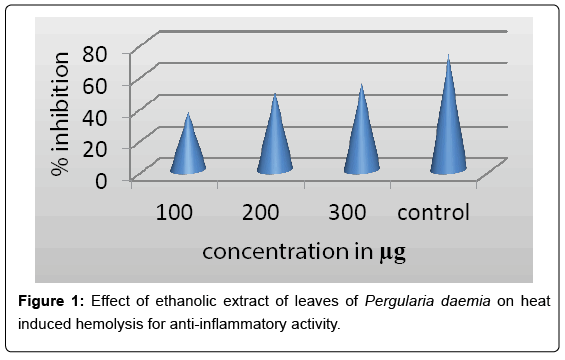
Figure 1: Effect of ethanolic extract of leaves of Pergularia daemia on heat induced hemolysis for anti-inflammatory activity.
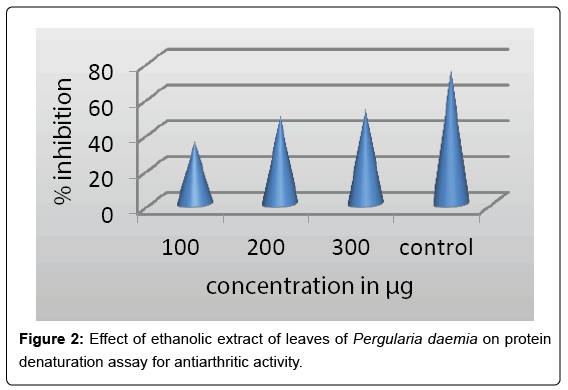
Figure 2: Effect of ethanolic extract of leaves of Pergularia daemia on protein denaturation assay for antiarthritic activity.
The maximum percentage stabilization was observed in ethanolic extract of leaves of Pergularia daemia about 54.55% at 300 μg/ml as compared to roots which has 45.55% at 300 μg/ml. It possesses significant activity comparable with that of the standard diclofenac sodium. Thus the roots and leaves of Pergularia daemia have significant anti-inflammatory activity which may be due the presence of triterpenoids, flavonoids, phenols, steroids etc.
In Vitro antiarthritic activity by inhibition of protein denaturation method
The effects of ethanolic extract of leaves and roots of Pergularia daemia on inhibition of protein denaturation are shown in Figures 3 and 4. Extracts of leaves and roots at different concentrations (dose levels) provided significant protection against denaturation of proteins. The maximum percentage inhibition was observed in ethanolic extract of roots about 58.89% at 300 μg/ml as compared to leaves 53.33%. It possess significant activity comparable to that of diclofenac sodium (100 μg/ml). From the results of present study it can be stated that ethanolic extracts of leaves and roots of Pergularia daemia is capable of controlling the production of autoantigen and inhibits denaturation of protein in rheumatic disease.
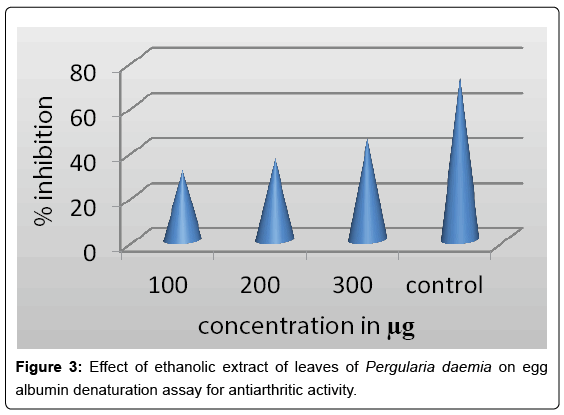
Figure 3: Effect of ethanolic extract of leaves of Pergularia daemia on egg albumin denaturation assay for antiarthritic activity.
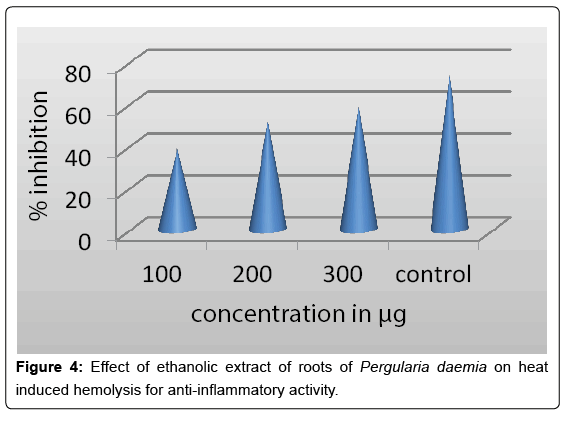
Figure 4: Effect of ethanolic extract of roots of Pergularia daemia on heat induced hemolysis for anti-inflammatory activity.
In Vitro antiarthritic activity by inhibition of albumin denaturation method
The effects of ethanolic extract of leaves and roots of Pergularia daemia on inhibition of albumin denaturation are shown in Figures 5 and 6. Extracts of leaves and roots at different concentrations (dose levels) provided significant protection against denaturation of proteins. The maximum percentage inhibition was observed in ethanolic extract of leaves about 58.62% at 300 μg/ml as compared to roots 53.33%. It possesses significant activity comparable to that of diclofenac sodium (100 μg/ml).
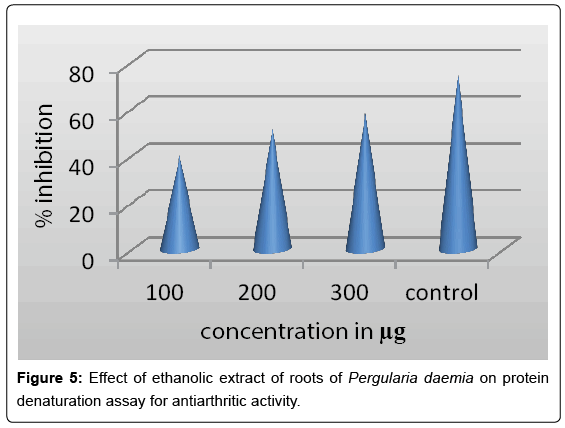
Figure 5: Effect of ethanolic extract of roots of Pergularia daemia on protein denaturation assay for antiarthritic activity.
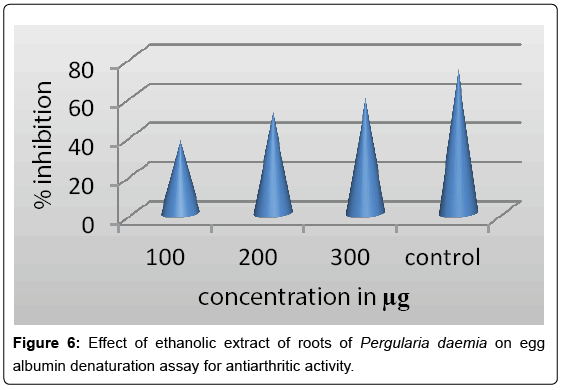
Figure 6: Effect of ethanolic extract of roots of Pergularia daemia on egg albumin denaturation assay for antiarthritic activity.
The present study revealed the In Vitro anti-inflammatory activity of ethanolic extract of leaves and roots of Pergularia daemia by HRBC membrane stabilization method where the ethanolic extract of leaves of Pergularia daemia produced maximum percentage of stabilization as 54.55% at 300 μl than that of roots and produce significant percentage of stabilization compared to that of standard diclofenac sodium. It reveals that the leaves of Pergularia daemia possess antiinflammatory activity whereas there are previous reports repeated in this plant, but Sreekumari et al. reported similar result in extracts of leaves of Rhizopora muconarata with significant percentage of stabilization about 95% at 400 mg/ml than that of standard diclofenac sodium (97%) by. Kumar et al. reported the significant percentage of stabilization as 69.9%, 85.9% and 74.2% in the methanol, ethanol and aqueous extract of Physalis angulata compared to diclofenac sodium (89.8%) and represented in the order of ethanol>water>methanol and also the methanolic extract of leaves of Cocculus hirsutus showed maximum percentage stabilization of about 88.8% at 1000 μg/ml than that of other in vivo and In Vitro (callus) parts was reported by Arya et al. and also Sheelarani et al. reported that the methanolic extract of Myxopyrum serratulum showed percentage stabilization as 61.25% at 200 μg/ml compared to standard diclofenac sodium. The present study revealed the In Vitro antiarthritic activity of ethanolic extract of leaves and roots of Pergularia daemia by the inhibition of protein denaturation and albumin denaturation. The ethanolic extracts of roots of Pergularia daemia produce increased percentage of inhibition of 58.89% at 300 μl when compared to the extract of the leaves and produced significant percentage of inhibition than that of diclofenac sodium. In the inhibition of albumin denaturation assay, the ethanolic extract of the leaves of Pergularia daemia produce increased percentage of inhibition of 58.62% at 300 μl when compared to ethanolic extracts of roots This may be due to the presence of terpenoids, tannins, steroids and polyphenol compounds such as flavonoids in the plant extract [12], whereas the previous studies has not reported in P. daemia, but the same study was reported in the extracts of leaves of Rhizopora muconarata which showed maximum percentage of inhibition and maximum percentage of inhibition in albumin denaturation assay was reported by Sreekumari et al. Sayeed et al. reported the significant percentage of inhibition of protein denaturation by the methanolic extract of leaves of Proteum serratum. The ethanol, methanol and aqueous extract of Physalis angulata produce significant percentage of inhibition of protein. Arya et al. reported the maximum percentage of inhibition of protein denaturation in the methanolic extract of the leaves of Cocculus hirsutus.
Conclusion
The result of the study shows that the ethanolic extract of the leaves of Pergularia daemia can be used in the treatment of arthritis due to the significant percentage of membrane stabilization and inhibition of protein denaturation.
Acknowledgements
The authors are thankful to the Management of Arignar Anna College (Arts and Science), Krishnagiri and to Principal, Arignar Anna College, Krishnagiri, for the constant help and support in conducting this work to full satisfaction.
22321
References
- WHO (1980) Expert Committee on diabetes mellitus. Second Report. Technical Report Series 646. World Health Organization, Geneva, pp: 2-15.
- Farnsworth NR (1990) The role of ethnopharmacology in drug development. In: Bioactive compounds from plants. Wiley, Chichester, UK, pp: 2-21.
- Subramoniam A, MadhavachandranV, GangaprasadA (2013) Review: Medicinal plants in the treatment of arthritis. Annals of Phytomedicine 2:3-36.
- Patwardhan B, Hopper B (1992) Ayurvedic and future drug development. J Alter Complement Med 19:9-10.
- Lipsky PE(2008)Rheumatoid arthritis.In: Harrison’s principles of internal medicine. 17thedn. McGraw Hill Companies,New York, USA 2: 2083-2093.
- Silman AJ, Pearson JE (2002) London epidemiology and genetics of rheumatoid arthritis. Arthritis Res 4: 265-272.
- Arya V, Gupta VK, Kaur R(2011)A Review on plants having antiarthritis potential. IntJPharmaceutSciRevRes 7:131-136.
- Singh SP, Verma S (2008)Natural products in anticancer therapy. Current and future status of herbal medicines. Vet World 1: 347-350.
- Pankaj O (2003) Doomar (or) gular (Ficusglomerata) as medicinal herbs in Chhattisgarh,India.
- Karthishwaran S, MirunaliniG, Dhamodharan M, Krishnaveni V, ArulmozhiA (2010) Phytochemical investigation of methanolic extract of the leaves of Pergulariadaemia.JBiolSci10:242-246.
- Sreekumari C, YasminN, Hussain R, BabuselvamM (2015) Invitro anti- arthritic property of Rhizoporamucronataleaves.International Journal of Pharma Sciences and Research 6: 3.
- Rose JC, Hina MI (2016) Comparative evaluation of phytochemical constituents of various extracts of leaves and roots of Pergulariadaemia. World Journal of Pharmacy and Pharmaceutical Sciences5: 1728-1736.















